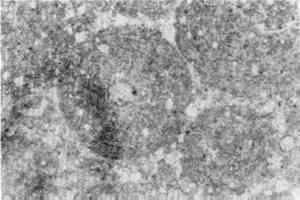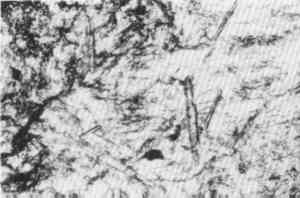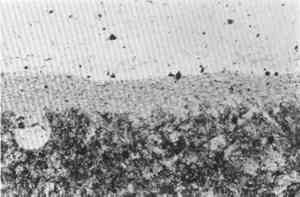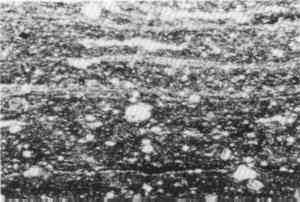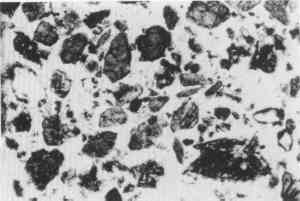THIN-SECTION PETROGRAPHY IN STUDIES OF CULTURAL MATERIALSCHANDRA L. REEDY
2 STONE2.1 STONE SCULPTURESThin-section studies of stone sculptures frequently aim to identify the stone material or find its source. Some of the sculptural materials that have been characterized are sandstone, limestone, marble, phyllite, schist, quartzite, granite, basalt, andesite, tuff, steatite, soapstone, gypsum, and others (Kempe and Harvey 1983; Newman 1984). A notable example is work on ancient Egyptian limestone sculptures (Harrell 1992). Many ancient quarries have been located in the Nile Valley, and samples from them have been characterized by thin-section analysis. Because of this work it is possible to identify the provenance
Marble sculptures, particularly from the Aegean region, have received much attention from thin-section petrographers. A systematic description (now outdated) of the petrography of classical marble quarries was published more than a century ago (Lepsius 1890). That work described features such as grain size, extent and orientation of metamorphic foliation, color, and presence of trace minerals. Later work expanded knowledge of the petrographic characteristics of specific quarries of the classical world (for example, Washington 1898; Marinos 1948; Weiss 1954; Herz 1955). These studies added the description of features such as preferred orientation of calcite grains, form of grain boundaries, and the degree and manner of recrystallization. Weiss (1954) and Herz (1955) also used identification of the preferred orientation of calcite to match fragments that had once been part of a single sculpture or inscribed slab. Renfrew and Peacey (1968) reviewed inaccuracies and inadequacies in Lepsius's work (1890). Some of these were due to incomplete petrographic descriptions, the use of subjective methods of analysis that did not include blinding or randomization, and sample sizes too small to characterize adequately the variation found in marble quarries. As the number of sampled quarries has increased, it is now recognized that no one method of analysis alone is sufficient for provenance studies of classical marbles, except when the possible source locations and comparisons are very limited. Inherent overlaps found when many potential sources are compared inhibit the effectiveness of petrographic, elemental, or isotopic data (Kempe and Harvey 1983). Therefore thin-section analysis is most useful for this material when used in combination with other methods, particularly if statistical analysis includes two or more types of data (for example, Lazzarini et al. 1980; Germann et al. 1988; Moens et al. 1988; Roos et al. 1988; Moens et al. 1989; Lazzarini 1990; Thin-section analysis has proven very useful in provenance studies of Gandharan schist sculptures from ancient Afghanistan and Pakistan (Courtois 1962–63; Lahanier 1976; Kempe 1982; Newman 1984; Kempe 1986; Newman 1992; Reedy 1992b). These Buddhist sculptures from northwest Pakistan show a clear mix of influences from both Greece and India. They are most often made of a shiny gray schistose material that has been identified in thin section as a carbonaceous phyllite or schist primarily consisting of quartz and muscovite, with chlorite sometimes present. An unusual feature is the prominent inclusions of tiny rods of chloritoid (fig. 3). Comparison with samples from possible quarry sites indicates that the sources were located within the Swat and Peshawar Valleys. Newman's (1992) microprobe analysis of the chloritoid inclusions has enabled further grouping of sculptures that probably derive from the same source.
Thin sections of stone sculptures have also been used in authenticity studies, as one way of examining the natural patina or weathering layers that may have formed since the surface was worked by the sculptor (fig. 4). The mineralogical and textural changes of the stone depend upon the type of stone (such as marble, tuff, schist, etc.) and its environmental conditions (such as burial in the soil or long-term outdoor exposure). For any combination of stone type and environmental condition we need a set of reference specimens that includes a variety of objects of known authenticity, and preferably some known to be forgeries. Newman (1990), building on earlier work on weathering layers (Hipkiss et al. 1937; Young and Ashmole 1968), discussed characteristics of marble weathering layers. he prepares thin sections without cover slips so they can also be used in electron beam instruments. Such background studies are not yet available for most classes of stone sculpture; the effects of common conservation treatments on the overall surface and on weathering layers have also received little research.
One of the earliest and most successful petrographic thin-section studies of artifacts was of ceramic materials excavated at the site of ancient Troy (Felts 1942). This study remains a model of the potential utility of thin-section analysis of ceramics and sherds. Three research questions were addressed in this study: (1) Among the ceramics excavated at the site, is it possible to distinguish local from imported wares? (2) Do ceramics produced in different time periods differ in thin section? (3) Can ceramic manufacturing methods be deduced from a study of ceramic structures and how they have been altered by firing conditions? Felts compared thin sections made from the ceramics and from soil samples taken in and around Troy. Most ceramic samples were found to have rock and mineral inclusions native to the local region and seen in the local soils (such as quartzite, a green hornblende trachyte porphyry, siltstone, and a strongly foliated mica schist). In a small percentage of the objects the inclusions consisted of minerals and rock fragments not seen locally (such as basaltic lava). Therefore, these objects were
Pottery and soils from various archaeological strata were examined for temporal changes. The earliest sherds were very porous (up to 20% of a typical thin section consisted of spherical and elliptical vesicles). Through time there was a clear change in technology toward smaller grain size for tempering materials, less porosity, and an increasing percentage of objects produced on a wheel. Only a few mineralogical differences were found among the different strata. The thin-section study successfully identified a variety of manufacturing approaches. The earliest clays showed fine, stream-rounded natural inclusions of quartz, feldspars, micas, and calcium carbonate minerals, indicating that detrital silts were collected with little or no purification. The purity of the clay increased over time and was accompanied by an increase in the use of added tempers. A lack of internal preferred orientation of grains and the haphazardly distributed porosity showed that a minimum of working was done during the shaping process. Firing occurred in a reducing atmosphere, producing gray pottery with reduced iron oxides and small amounts of carbon from organic matter. However, frequent patches of oxidized materials showed that the firing conditions were not well controlled. Very few sherds reached temperatures high enough to cause calcite to disintegrate. Over the years a large number of successful provenance studies of ceramic vessels have used thin-section petrography (Peacock 1970; Williams 1983). These studies usually involve analyzing the larger-grained tempering material and comparing it to potential geological sources (for exact pinpointing of manufacturing sources) or to temper material from other ceramic samples (for relating objects that might have a common source). These studies have involved ceramic traditions from a wide range of regions such as the American Southwest (Shepard 1942), Greece (Farnsworth 1964) and the West Indies (Donahue et al. 1990). One particularly interesting example is work carried out on sand-tempered Pacific Island ceramics. This work helped to reconstruct the history of the settling of the islands by providing evidence for the movement of people from one island or island group to another (Dickinson and Shutler 1974; Dickinson and Shutler 1979; Dickinson et al. 1990). Island potters were relatively restricted in their choice of where to obtain sand tempers, generally to those available within their island or local island cluster. After petrographically characterizing the sands of 50 islands and 15 major island groups, the researchers were easily able to identify local versus imported ceramics. When objects found on one island were clearly made elsewhere, the patterns of past human movement could be Some ceramic petrographers are more interested in understanding the wider context of ceramic technology than in provenance (Hodges 1963; Freestone et al. 1982; Middleton and Freestone 1991). Although they draw on methods of sedimentary petrography and soil micromorphology, they note that since ceramics are made by humans, the methods of geologists are not sufficient for understanding ceramic fabric variations caused by human interactions with raw materials. Thus ceramic petrographers are working to develop their own methods to describe ceramic fabrics in such a way as to highlight both the nature of the raw materials and the effects of ceramic technology (Whitbread 1989). 2.3 TERRACOTTA SCULPTURESSince it is a coarse ceramic material, terracotta should theoretically be suitable for provenance studies by thin-section petrography. It tends to have high amounts of heavy minerals (such as olivine, zircon, hornblende, hypersthene, garnet, tourmaline, rutile, epidote, and chloritoid) known to be extremely sensitive indicators of provenance (Morton 1985). However, no major studies focusing on petrography of terracotta sculptures have as yet been published. In a pilot study of three Gandharan terracotta sculptures, major differences were found in the coarse-grained fractions (Reedy 1992a). A hooded female figure contained a fine-grained quartz in a hematite-rich clay, with accessory amounts of muscovite, gypsum, anhydrite, carbonates, clinopyroxene, and iron oxides (fig. 6). A female bust also contained primarily fine-grained quartz along with the clay and accessories of plagioclase feldspar, muscovite, chloritoid, and hypersthene. However, a bearded head was formed with a material that
2.4 ARCHITECTURAL CERAMICSArchitectural ceramics such as bricks and terracotta tiles are amenable to thin-section studies for identification of components, provenance studies, assessment of deterioration, or monitoring of conservation treatments. In one example, thin sections of bricks, roof tiles, and floor tiles from York, England, were studied from a variety of medieval and postmedieval structures. The results showed that although the majority of York's ceramic building materials were of local manufacture, some were imported to the area during various periods (Betts 1991). Among the materials manufactured locally, some functional and chronological differences became apparent through analysis of grain size distribution. (Grain size distribution for a thin section is an estimate of the fraction of grains in each of several size classes.) |

